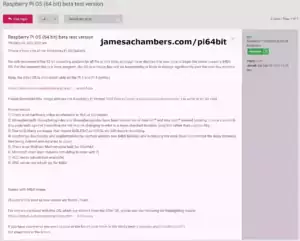
Last year a official 64 bit version of Raspberry Pi OS was released. There have been 3 versions of the image released with the latest one just having came out April 9th 2021.
It can be a little tricky to find and I’ve been asked in the comments here before on the site where to find it so I figured it was time to write a quick guide!
Hardware Used
The Raspberry Pi 400 kit includes everything you need for a full Pi 400 desktop build. The Pi 400 is the fastest Raspberry Pi ever released and comes in the form factor of a keyboard!
Links: AliExpress*, Amazon.com*, Amazon.ca*, Amazon.com.au*, Amazon.co.jp*, Amazon.co.uk*, Amazon.de*, Amazon.es*, Amazon.fr*, Amazon.it*, Amazon.nl*, Amazon.pl*, Amazon.se*, Amazon.sg*

The Raspberry Pi 4 is available in different memory configurations all the way up to 8 GB. It’s about the size of a credit card and uses an extremely low amount of power making it ideal for all sorts of projects and ideas!
Links: AliExpress*, Amazon.com*, Amazon.ca*, Amazon.com.au*, Amazon*.co.jp*, Amazon.co.uk*, Amazon.de*, Amazon.es*, Amazon.fr*, Amazon.it*, Amazon.nl*, Amazon.pl*, Amazon.se*, Amazon.sg*
Pi OS 64-bit Image Location
All the beta 64 bit Raspbian images released can be seen at this URL:
https://downloads.raspberrypi.org/raspios_arm64/images/
You’ll see a directory listing like this:
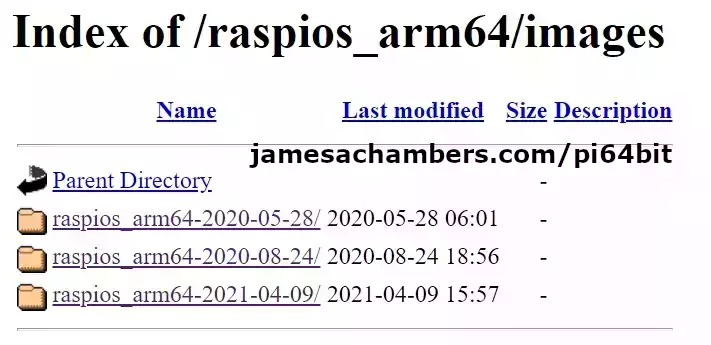
Click on the folder for the latest image available (4-9-2021 at time of writing).
Pi OS 64-bit Image File
The contents of the image folder we selected in the previous step will look like this:
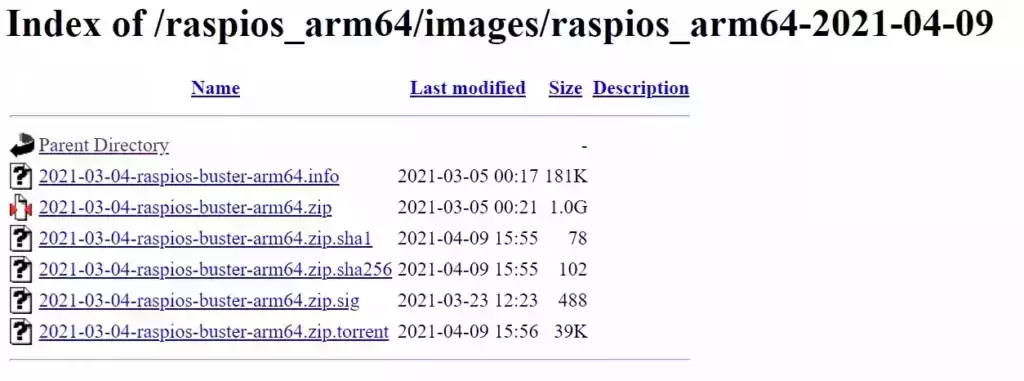
The only file most of you will be interested in is the zip file. That contains the entire 64 bit image compressed to a size of about 1 gigabyte. Click the zip file to download it!
Once the download has completed extract the zip file which contains a .img file. In Linux we can extract the file sometimes by just right clicking in the GUI or from the command line using the command:
unzip 2021-05-07-raspios-buster-arm64.zipIf it says you don’t have the unzip utility you can install it with sudo apt-get install unzip. Extraction will take a few moments/minutes on the Pi and then you will end up with the raw .img file in the directory you ran the unzip command. This is the file we will write to our storage!
Writing 64-bit Image to Storage
The recommended way to write the 64 bit image to your storage device is using the Raspberry Pi Imager tool. This works with both SD cards and USB attached storage devices like SSDs/HDDs.
Using this tool for the first step (Operating System) we scroll to the very bottom to select “Use custom”:
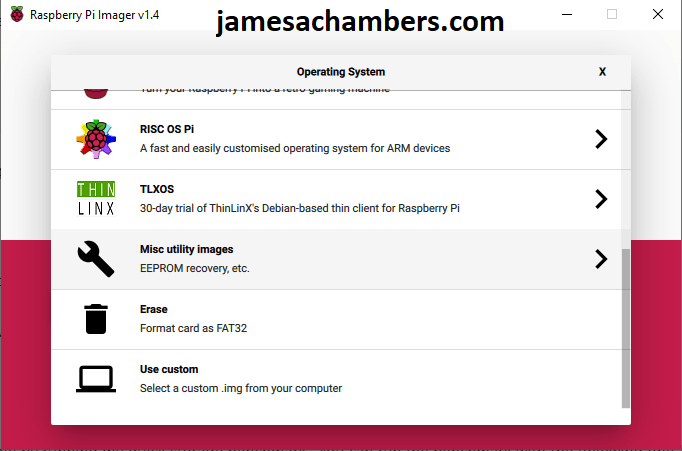
Once you select this option a prompt will open. From here you can select the .img file we extracted earlier and write the image!
Benchmarking / Testing Storage
Once you’ve booted up you can verify your drive’s performance using my storage benchmark with:
sudo curl https://raw.githubusercontent.com/TheRemote/PiBenchmarks/master/Storage.sh | sudo bash
If you search for the model of your drive on pibenchmarks.com you can compare your score with others and make sure the drive is performing correctly!
Other Resources
To find out how to add a UPS backup battery to your Pi check out my UPS for Raspberry Pi guide
If you’re trying to set up SSD / USB storage booting check out my Raspberry Pi USB booting setup guide
To find out where to get the 64 bit version of Raspberry Pi OS view Where to get the 64 bit Raspberry Pi OS image
For benchmarks and recommendations on the fastest storage drives/adapters for the Raspberry Pi check out my 2021 Storage Roundup
If you’re having firmware issues and need to update/restore your firmware: Raspberry Pi firmware guide here
For my new overclocking and SSD setup guide for the Pi 400 check out my Pi 400 Overclocking and SSD setup guide





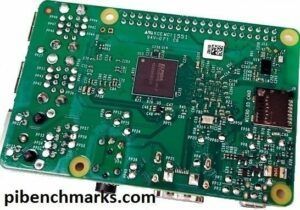

21 Dec 2021 : There seems to be a problem with the screen drivers for Pi4 with the latest version of bullseye. I downloaded 2021-10-30-raspios-bullseye-arm64.zip and wrote the card – when I booted the pi, it did some stuff (resized and rebooted, showed the rainbow flash) and then booted to a black screen – never to return.
The magic foo is here on reddit.
In the config.txt file, adjust
dtoverlay=vc4-kms-v3dto bedtoverlay=vc4-fkms-v3dThe extra ‘f’ gets the device to use the old driver
No doubt that this will get fixed in time, however for now this may well be of some help to someone..
Hey Tim,
Thanks for leaving this! I had not heard of / encountered this personally yet but for Bullseye. When the Pi 4 first came out though the video driver had issues on some configurations as well.
No doubt this will help a lot of others, thanks again Tim!
Cant believe I had to search for this info, it’s utterly ridiculous that 64bit is not the default, let alone not even an option in the recommended installation tool!
The info is appreciated, thanks.
Hey Adrian,
Glad it could help, and thanks for leaving me a comment letting me know it’s useful to someone out there, take care!
very, very useful
it is bizarre there arent proper forums free from the political nutjobs censoring everything covering things like this. It is getting harder and harder to find information and for normal people to communicate.
I might add – the terminal commands to format and write the image would be useful, so that dependence on the RP SD imager and downloading it isn’t required – Then you don’t need to rely on having a working internet connection – which in some situations (physical, corporate, etc) is a real limiting factor.
You can actually just load the .zip file into the imager – no need to unzip it first.
Thanks for the tip Brian! That will come in handy because extracting some of those archives is *very* slow. Cheers!
How do I do the extract thing.
I also saw in one of your videos you do such thing.
Have your wrote any such guide/video. please point me to a link.
Enec
Hey Enec,
Great question, I should update the article and add that in there. The easiest way is to use the “unzip” command. So you would open a terminal and cd to your Downloads folder or wherever you saved the image and use:
unzip 2021-05-07-raspios-buster-arm64.zipIt will take a few minutes usually on a Raspberry Pi but then the raw image file will appear in your folder. This is the image you can use in the Pi Imager tool or your other favorite image writing software like Etcher, etc. Hopefully that helps!
Oui encore plus facile Merci